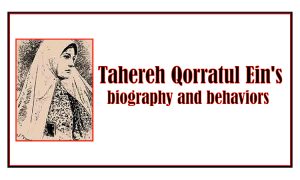آنچه در ادامه می خوانید
Fatemeh Baraqani (1232-1268 S.H.) is a woman who was born in a scientific Baraqani family in Qazvin city. He was entitled as “Qorratul Ein”, “Zarrin Taj”, “Badruddoja”, “Shamsuzzuha”, and even “Tahereh”. She was the offspring of Mullah Muhammad Saleh Baraqani and Ameneh Qazvini. Her elder paternal uncle, Mullah Muhammad Taqi Baraqani was a clergyman of religious jurisprudence and prayer leader on Fridays of Qazvin city and he was also one of the top scholars of Iran. Qorratul Ein and her sister were clever to educate. She got married with her paternal uncle’s son; Mullah Muhammad, the offspring of Mullah Muhammad Taqi.
Qorratul Ein was interested in religious sciences. She got acquainted with principles and beliefs of Sheikism via her younger paternal uncle’s son, Mullah Ali. Then, she starting writing letters for Seyyed Kazem Rashti and Sheikh Ahmad Ehsaee (the founder of Sheikism). During those letter writings, Seyyed Kazem called her “Qorratul Ein” and invited her to Karbala city.
Qorratul Ein accepted Seyyed Kazem Rashti’s invitation and left his husband and three offspring; although there were differences between Sheikism and Shiism theologically and albeit her husband and father-in-law were Shiism high-minded. According to Modarresi, she announced herself as divorced contrary to the religious law of Islam[1]. Anyway, when she entered into Karbala city, the dead body of Seyyed Kazem Rashti was being expelled from his house and didn’t meet each other anymore. Anyway, Qorratul Ein remained in Karbala city and held class in Rashti’s house proselytizing for Sheikism.
Sheikh Ahmad Ehsaee and Seyyed have introduced 13th century as the period of gate of Imam of the Time and annunciated for the emergence of a promised one. Also, they had said to Sheikis about the succession of Sheikism that they should have sought for a person to appoint him as leader. During this period of time, “Ali Muhammad Shirazi claimed for being the gate for imam of the Time in Shiraz city. Mullah Hussein Boshrouyee who is one of Seyyed Rashti’s pupils and was apparently searching for the savior of the world referred to Ali Muhammad.
Qorratul Ein was of the pupils waiting for the promised one: According to Seyyed’s statement and based on her certainty, when the Excellency Mullah [Hussein Boshrouyee] was searching for the truth sun; she had written a petition and believed in invisibly.[2]” Earlier this time, she had written for this promised man and given to Boshrouyee to show her faith as soon as he found the person. In his first stage of his heavy claim, Ali Muhammad Shirazi was severely in need of adherents to confirm him. He appointed Qorratul Ein as one of Hayy letters or one of his main disciples although Bab hadn’t seen her at all. She never saw Ali Muhammad.[3] [4] [5]
This matter clarifies two important issues: 1) Qorratul Ein had become Babi and 2) attracting people and using this woman’s family fame were so conspicuous for Sheikism and Babism that the Babism head had considered her as his main disciples without any evaluation and definite activity and used her name. Generally speaking, cults possess a great deal of motivation to attract scientists towards themselves.
It is said in the Baha’is historical works: “It was the Excellency Tahereh’s custom that she was unveil in the disciples’ assembly; but when strangers were present, she was speaking in a hidden manner. When the Excellency Tahereh was emerging unveiled some disciples were wonky and saying why she is excommunicating the commandments of the religious law.[6]“
During this period of time, some Babis wrote opposing letters to Ali Muhammad; but Ali Muhammad introduced Qorratul Ein as honest, learned, active and chaste woman to make the opponents silent.
It is interesting to be investigated that such titles are being given to Qorratul Ein without any attribution. Anyway, Qorratul Ein possessed special position among Babism adherents.
sedition plain
When Ali Muhammad was imprisoned in Makou prison, Tahereh Qorratul Ein, Mullah Muhammad Boshrouyee, Hussein Ali Nouri and several Babis gathered in Badasht plain located at Shahroud city to plan to abolish Islamic religious law. They planned for this issue to be announced by a woman. Tahereh accepted to do this job.
At that famous day, Tahereh appeared unveiling and said: “…we are in Fetrat period of time now. So, tear up the cover between you and women. Share your jobs with women after enjoying fruition. Have intercourses with them… They are life flowers. Smell them with extreme enjoyment.[7]
This was a short biography of Qorratul Ein. She believed in Babism in which assassination, beheading, making non-Babi books fire, destroying tombs and resting places were of its leaders’ advice. She obeyed and proselytized for this Babism, a non-heavenly creed which was apparent in practice.
[۱] Abdiyaee, Narejs, the role and position of Qorratul Ein in Babism cult, waiting for the promised one of Islam, winter 1388- No. 31.
[۲] Jani Kashani, Hajji Mirza, Noqtatul Kaf, 1910 A.D., p. 140.
[۳] Abdiyaee, Narjes, Ibid.
[۴] Afrasyabee, Bahram, the comprehensive history of Baha’ism, Tehran: Sokhan, 1374, p. 104
[۵] Amini leyla, the investigation of Sheikism & Babism cults in the Holy Shrine during Qajar dynasty, Ordibehesht 1393, 6th year, No. 33.
[۶] Afnan Abul Qasem, four historical articles about Tahereh Qorratul Ein, Germany: The New Era, p. 23.
[۷] Zaeemudduleh Tabrizi, Mirza Mahdi, Bab and Baha history, Tehran: Farahani press intitute, 1346 S.H. pp. 133-134.






